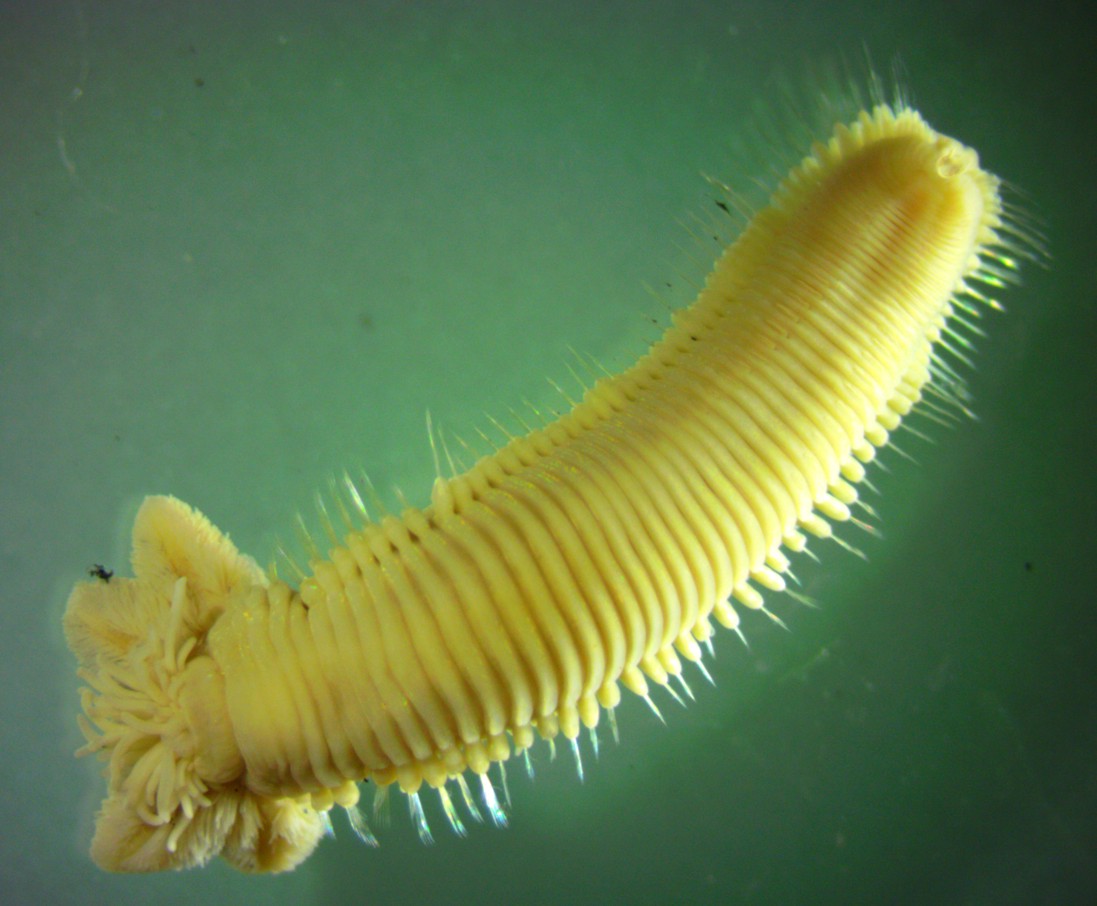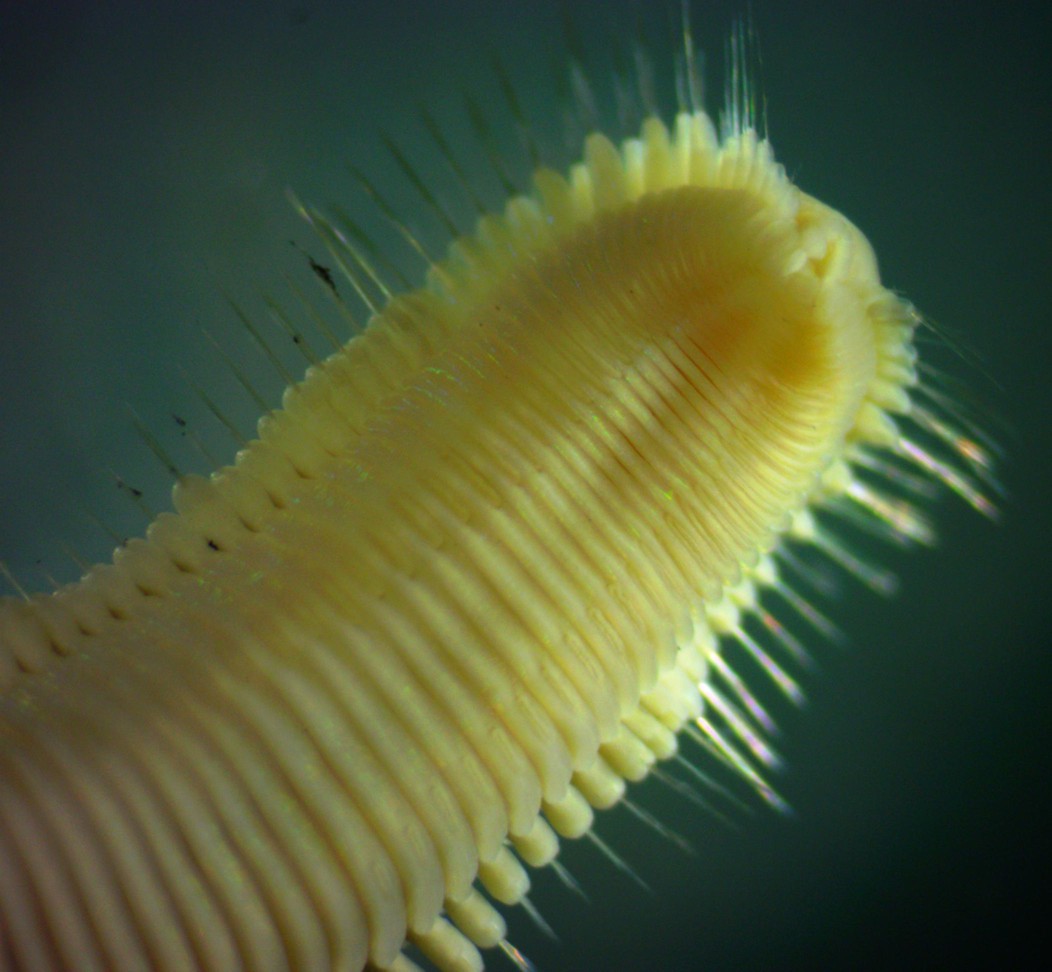Description: Order Canalipalpata are the bristle-footed Annelids or fan-head worms. They have no jaws or teeth. Most have grooved, ciliated tentacles with which they feed. Terebellids are mostly sessile tubeworms. Family Alvinellidae is found in the deep sea at hydrothermal vents. They usually build mucus tubes and feed with flattened, ciliated tentacles, plus obtain nutrition from episymbiotic bacteria living on their surface. Paralvinella sulfincola has a body which tapers only a little through its length, then tapers sharply at the last 10 or so segments. It has 54-68 chaetigerous segments (setigers), the first 24-30 of which have only notopodia (no neuropodia) (photo). The first 22 notopodia (except #7) have a fingerlike lobe dorsally (photo). Setiger 7 has setae strongly modified into 4-5 very large, strong hooks which arise from the notopodium and curve posteriorly (photo). The buccal apparatus consists of small grooved, ciliated tentacles (photo) and one pair of large basal tubercles. In males there are also two large lateral tentacles which have a curved margin at the end. Have four pair of featherlike branchiae (gills), which fan out anteriorly, dorsal to the feeding tentacles. Color bright red or orange in life. May turn brown after preservation in formalin.
How to Distinguish from Similar Species: Of paralvinellid worms at Pacific Northwest hydrothermal vents, Paralvinella palmiformis has a body with 100-118 segments, and tapers gradually toward the posterior end. Its first 20-31 segments have no neuropodia. P. pandorae has only about 60 chaetigerous segments and only the first 3 chaetigerous segments have no neuropodia. In all 3 species chaetigerous segment 7 has highly modified setae (stout hooks directed backward).
Geographical Range: Pacific Northwest hydrothermal vent fields: Explorer Ridge, Juan de Fuca Ridge, Gorda Ridge.
Depth Range: Around 2000 m
Habitat: On sulfide chimneys at hydrothermal vents, on surfaces ranging from 20-80 degrees C.
Biology/Natural History: These worms live under some of the hottest temperature conditions on earth (on sulphide chimneys at hydrothermal vents). Conditions around these chimneys (due to vent water) also include hypoxia or anoxia and high levels of hydrogen sulfide. Their lowest preferred temperatures are 4 to 20 C, which is warmer than the normal bathyal water temperatures but reflect moderate heating by hydrothermal vent waters (Bates et al, 2013). They have been collected from sites as high as 42-68 C (Yancey et al., 2009). Enzyme studies (Rinke and Lee, 2009) suggest that the high lethal themprature is about 63 degrees C. At the highest temperatures they experience, this species upregulated the synthesis of glutathione, downregulated NADH- and succinate-dehydrogenases, and maintained a high level of heat-shock proteins (Dilly et al., 2012). These characteristics may be related to their ability to mitigate oxidative stress at high temperatures. The major osmolyte in this species is glycine. Thiotaurine, which may be used to detoxify sulfide, was at a higher level than found in other paralvinellids such as P. palmiformis. The hypotaurine and sarcosine contents of the branchiae were higher in the gills than in the body (Yancey et al., 2009). Aerobic metabolism appears to dominate in the gills, while anaerobic metabolism (glycolysis) appears to be more prominent in the body wall (Rinke and Lee, 2009).
Paralvinellid worms consume a varied diet, including
feeding
on the
bacteria and mucus coat around them. Stable isotope ratios
indicate
that P.
sulfincola's food
source is strongly based on bacteria rather than on other particulates.
(Limen et al., 2007). The diet of this species also may
include dead
Stygiopontius quadrispinosus copepods, which
are
common around vents
where they feed on vent bacteria (Limen et al., 2008).
| Return to: | |||
| Main Page | Alphabetic Index | Systematic Index | Glossary |
References:
Dichotomous Keys:General References:
Scientific Articles:
Bates, Amanda E., Tomas J. Bird, Katleen Robert, Kirt Onthank, Gerry Quinn, S. Kim Juniper, and Raymond W. Lee, 2013. Activity and positioning of eurythermal vent sulphide worms in a variable thermal environment. Journal of Experimental Marine Biology and Ecology 448: pp 149-155
Dilly, Geoffrye F., C. Robert Young, William S. Lane, Jasmyn Pangilinan, and Peter R. Girguis, 2012. Exploring the limit of metazoan thermal tolerance via comparative proteomics: thermally induced changes in protein abundance by two hydrothermal vent polychaetes. Proceedings of the Royal Society B-Biological Sciences 279:1741 pp 3347-3356
Juniper, S. Kim, and Pascale Martineu, 1995. Alvinellids and sulfides at hydrothermal vents of the eastern Pacific: A review. American Zoologist 35:2 pp 174-185
Limen, Helene, Christian Levesque, and S. Kim Juniper, 2007. POM in macro/microfaunal food webs associated with three flow regimes at deep-sea hydrothermal vents at Axial Volcano, Joan de Fuca Ridge. Marine Biology 153: pp 129-139
Limen, H., C.J. Stevens, Z. Bourass, and S.K. Juniper, 2008. Trophic ecology of siphonostomatoid copepods at deep-sea hydrothermal vents in the northeast Pacific. Marine Ecology Progress Series 359: pp 161-170
Rinke, C. and R.W. Lee, 2009. Pathways, activities, and thermal stability of anaerobic and aerobic enzymes in thermophilic vent paralvinellid worms. Marine Ecology Progress Series 382: pp 99-112
Yancey, Paul H., Joanna Ishikawa, Brigitte Meyer, Peter Girguis, and Raymond W. Lee, 2009. Thiotaurine and hypotaurine contents in hydrothermal-vent polychaetes without thiotrophic endosymbionts: correlation with sulfide exposure. Journal of Experimental Zoology Part A-Ecological Genetics and Physiology 311A:6 pp 439-447
Web sites:
General Notes and
Observations: Locations,
abundances, unusual behaviors:
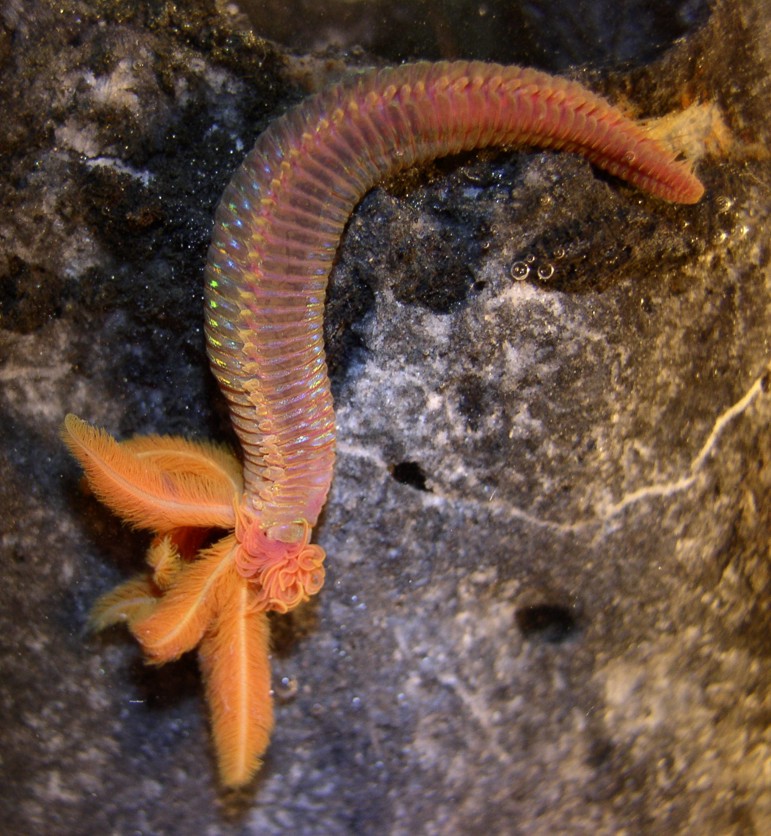 |
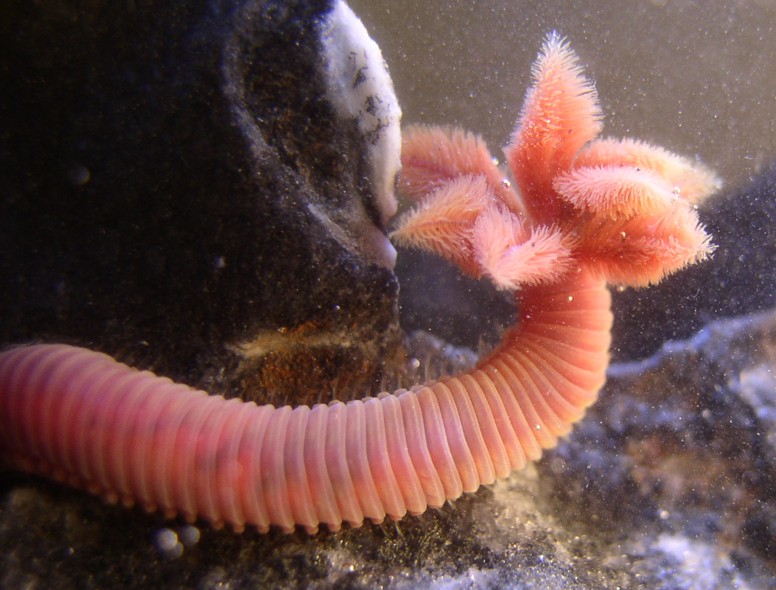 |
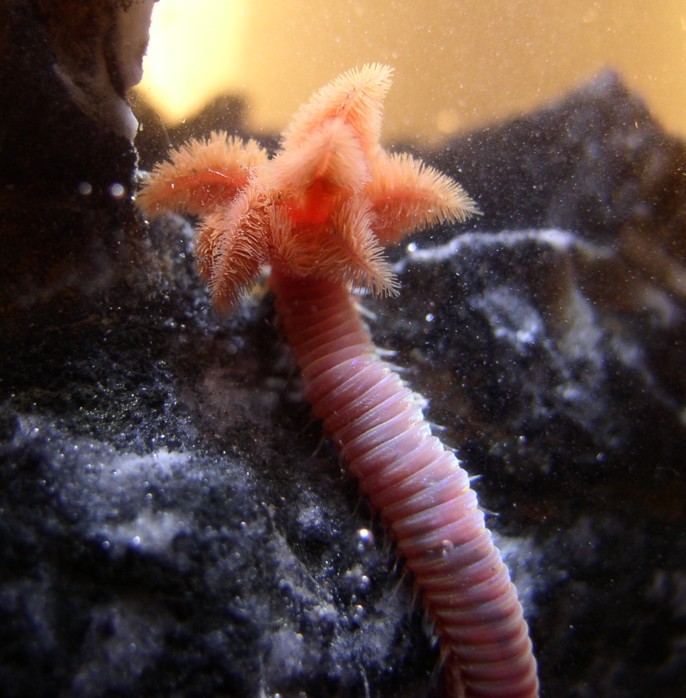 |
and for providing me the preserved specimens photographed on this page (below).
This photo shows a ventral view.
| Dorsal and ventral views of the head. | |
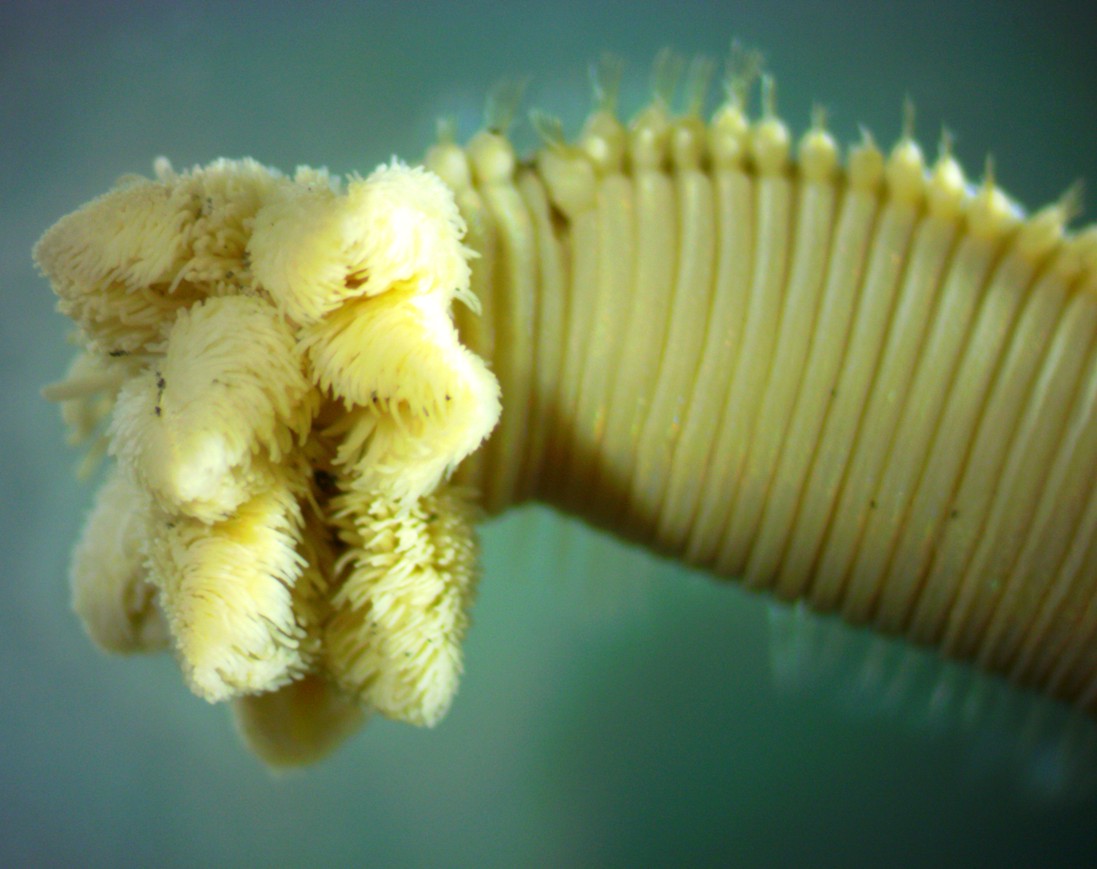 |
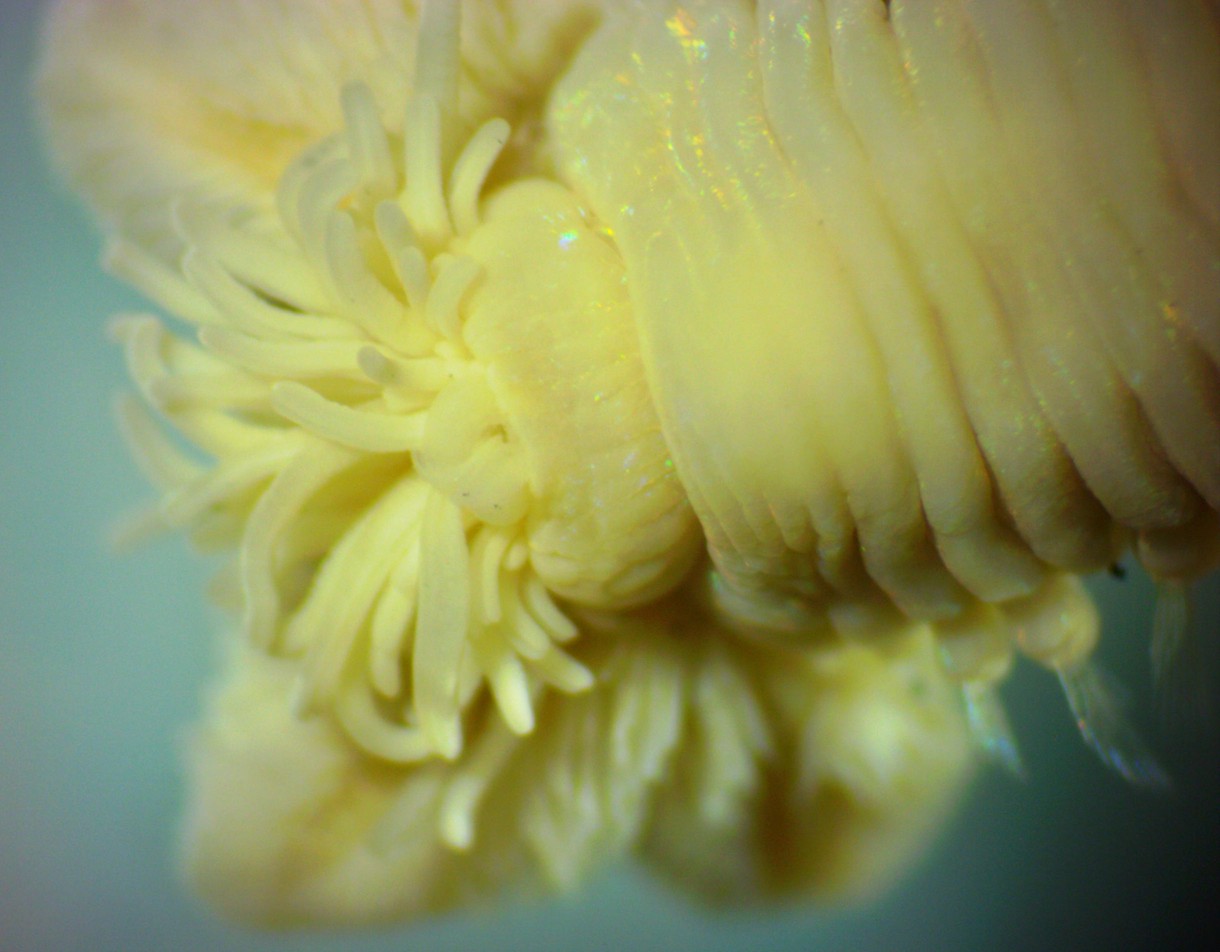 |
| Dorsal view of head, with the prominent featherlike gills. Note also the prominent parapodia (notopodia) with long notosetae. | Ventral view of the head, showing the flattened, ciliated feeding tentacles. The underside of the notopodia can be seen but no neuropodia nor neurosetae. |
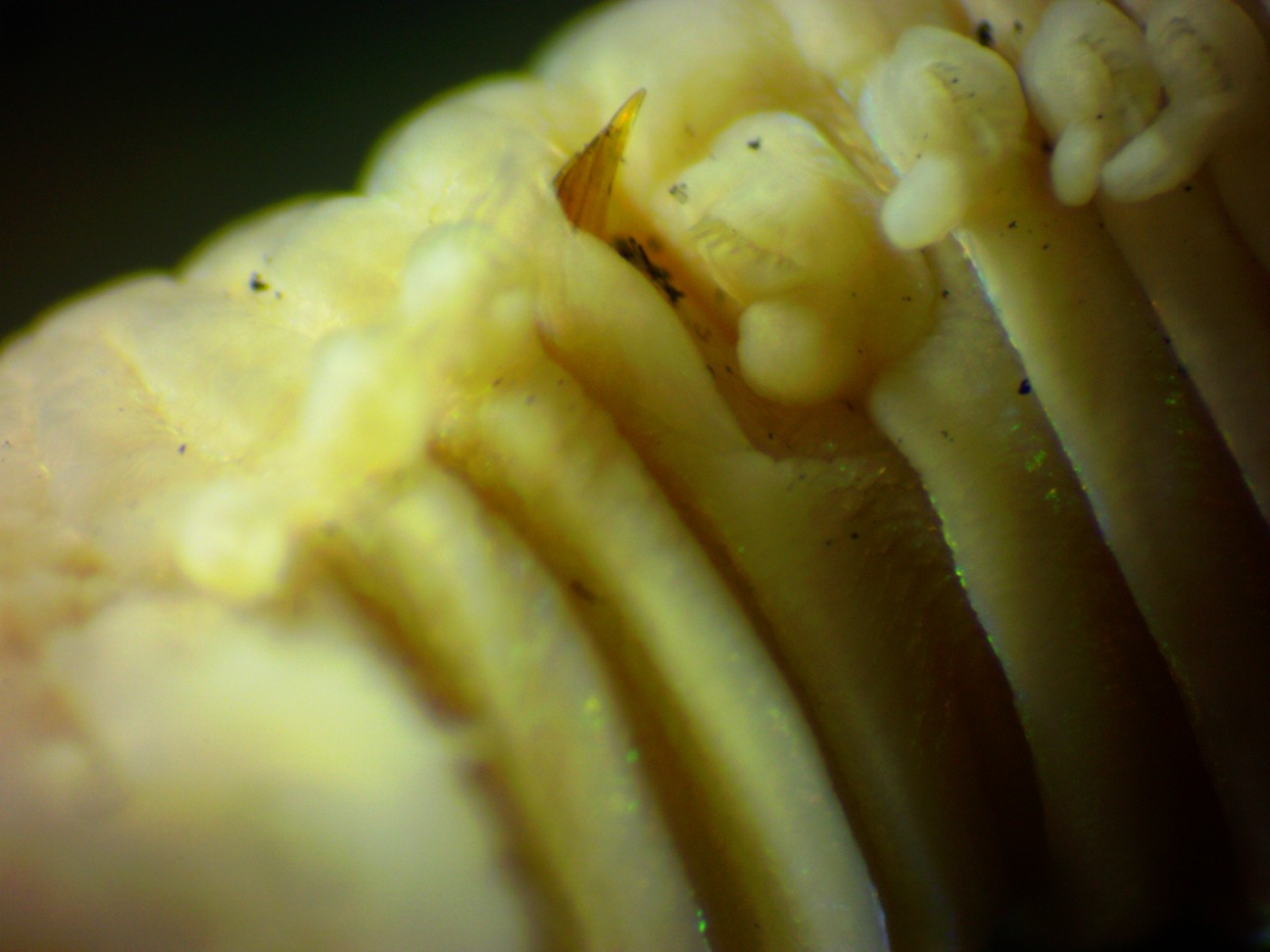
This dorsal view of the anterior body clearly shows the greatly
enlarged,
backward hooked setae
on
setiger
7. Anterior
is to the left. Note also the dorsally-projecting, fingerlike
projections
from the other anterior notopodia.
This ventral view of the posterior end and anus of the
animal
shows
the much smaller neuropodia
with very short neurosetae,
along with the prominent notopodia
and notosetae.
The neuropodia
are
barely raised and the neurosetae
are visible as a small row of tiny hooklike setae, probably in the form
of uncini
as is common
for neurosetae
in
other Terebellids.
Authors and Editors of Page:
Dave Cowles (2014): Created original page
CSS coding for page developed by Jonathan Cowles (2007)
Salish Sea Invertebrates web site provided courtesy of Walla
Walla University
